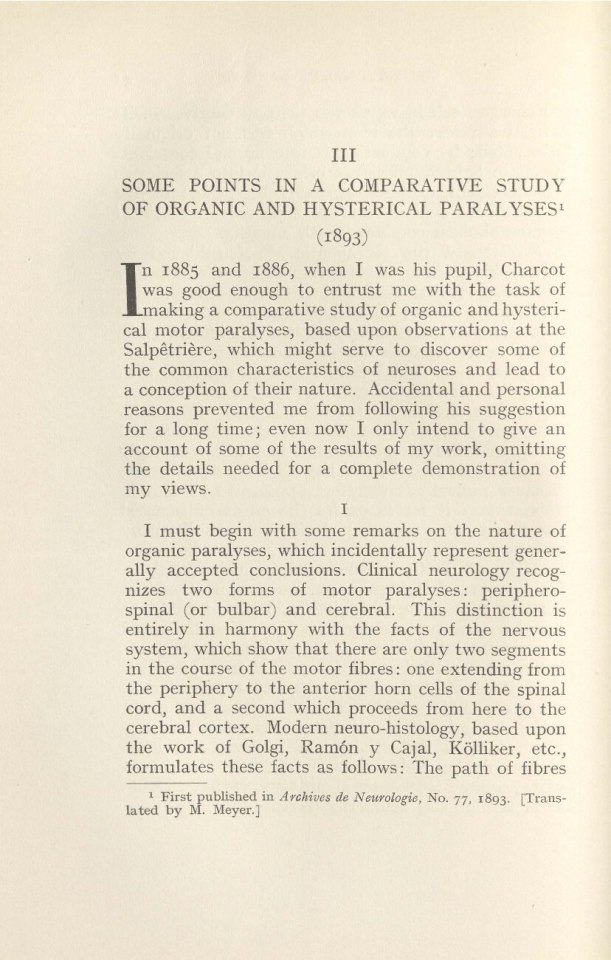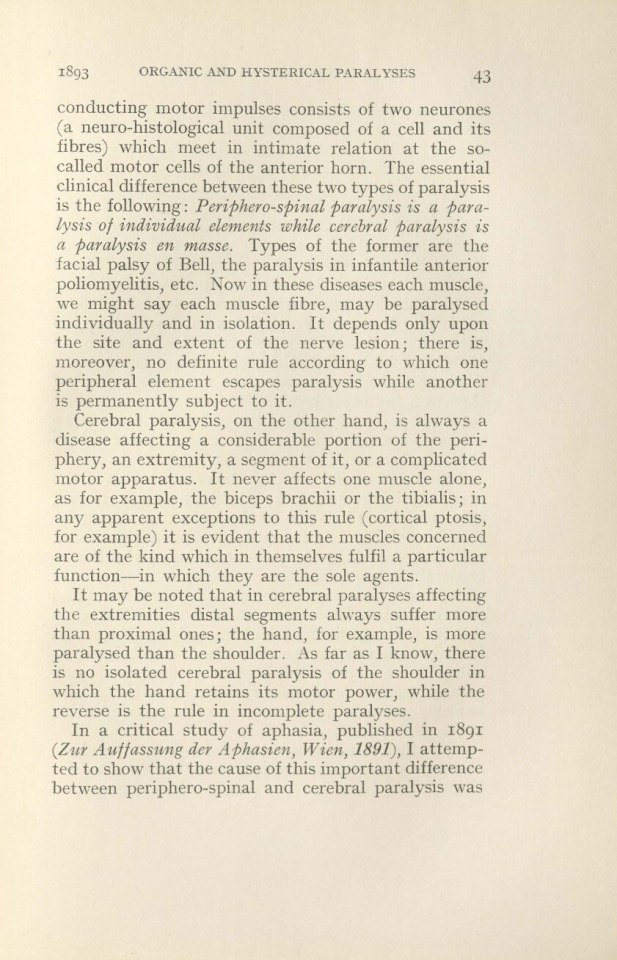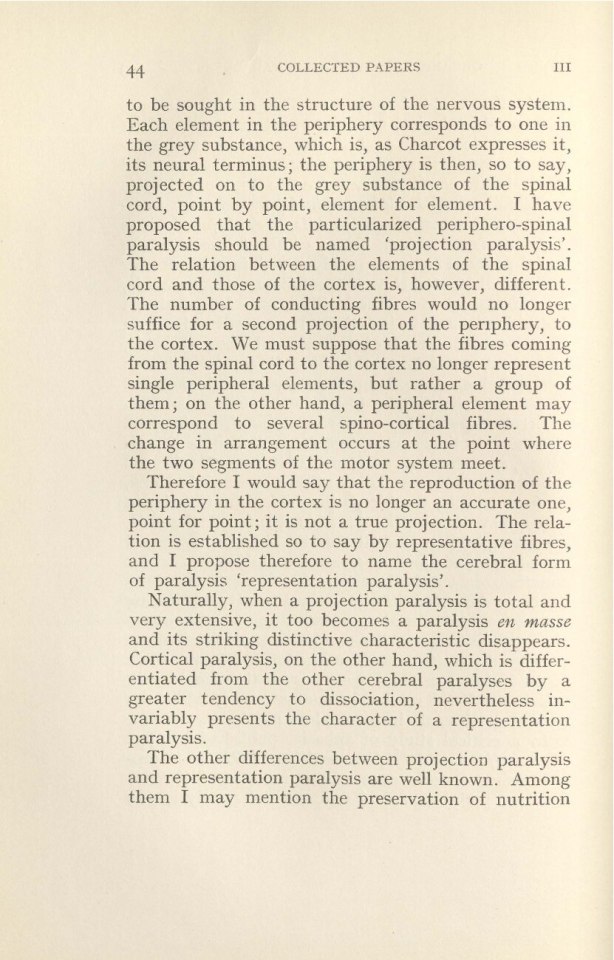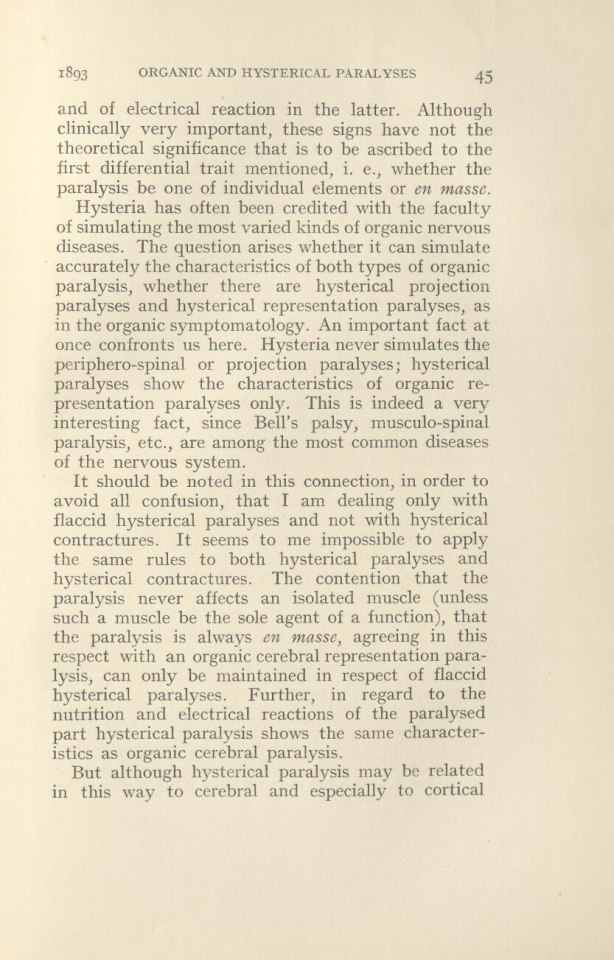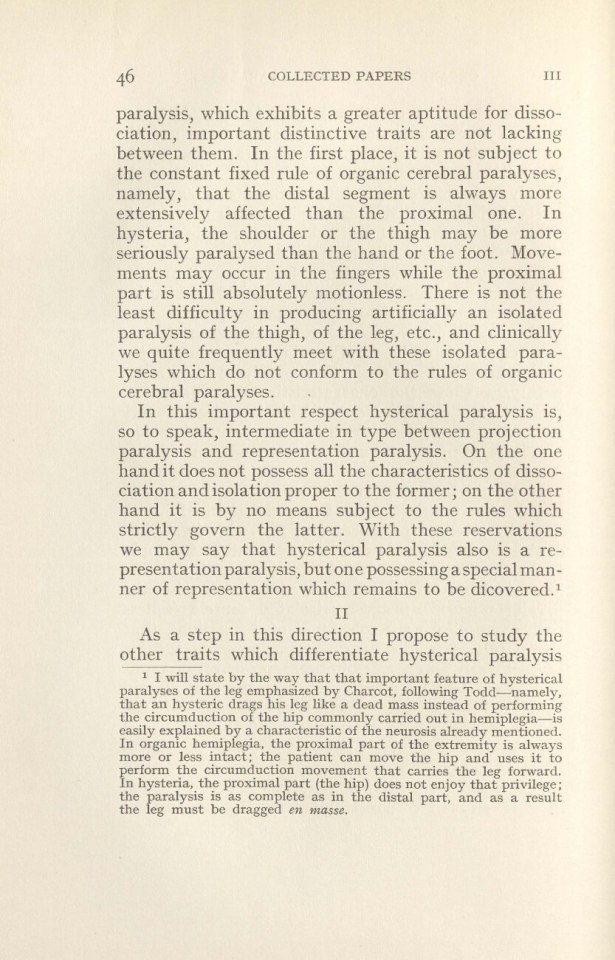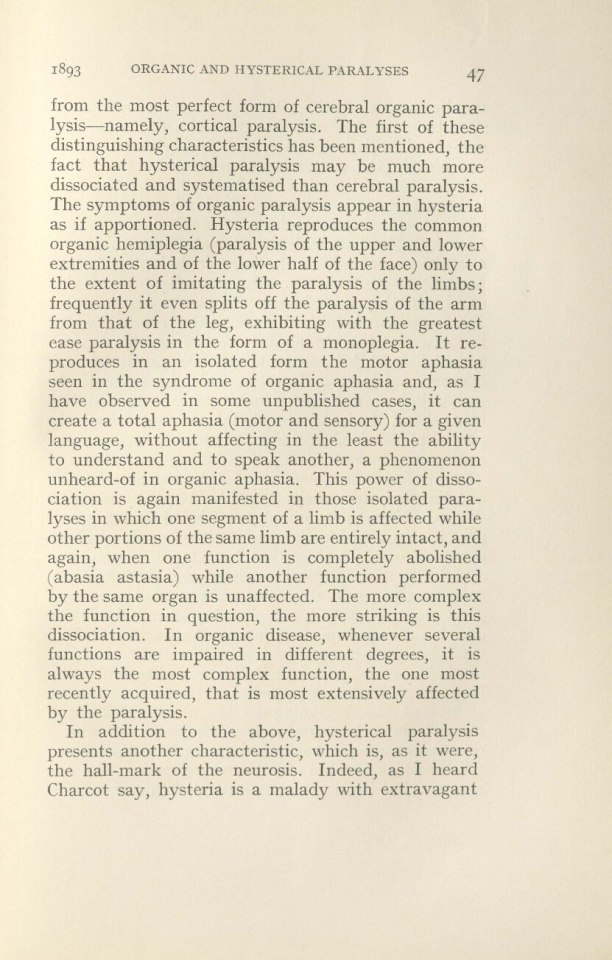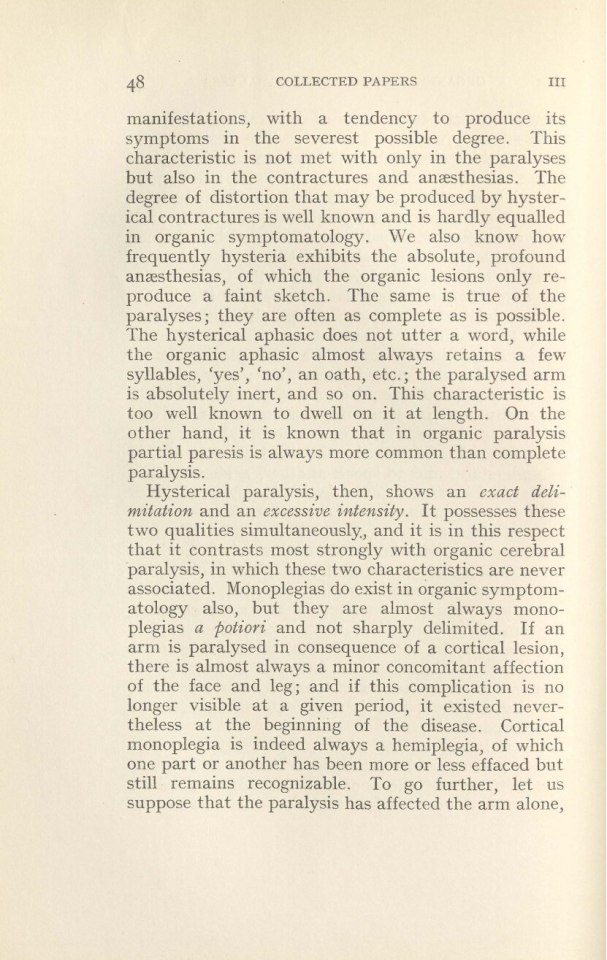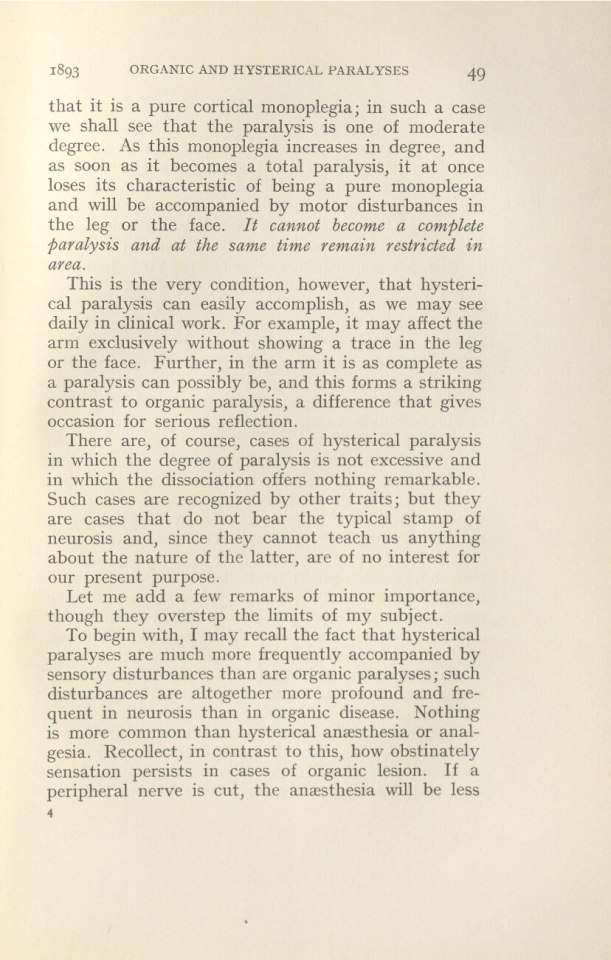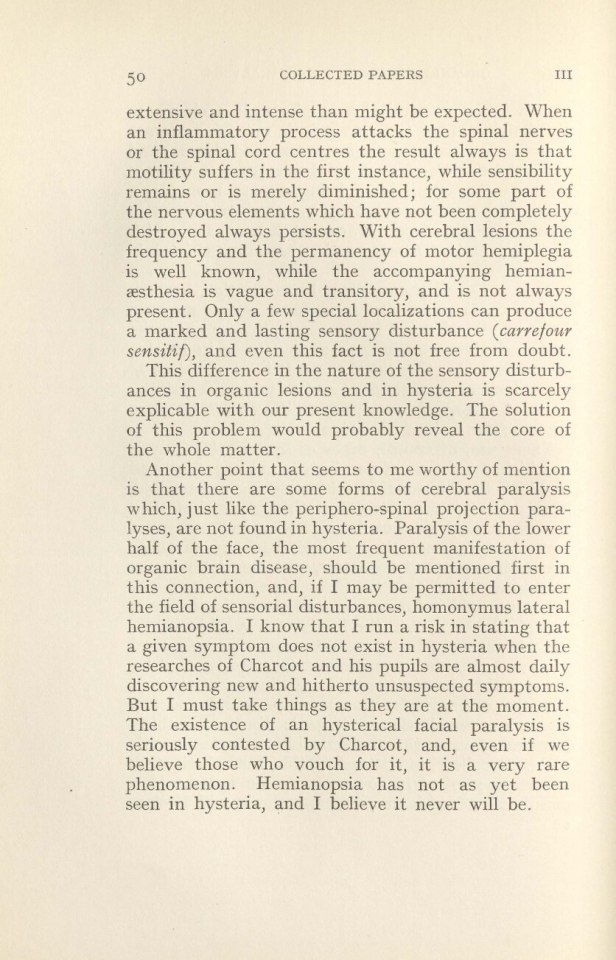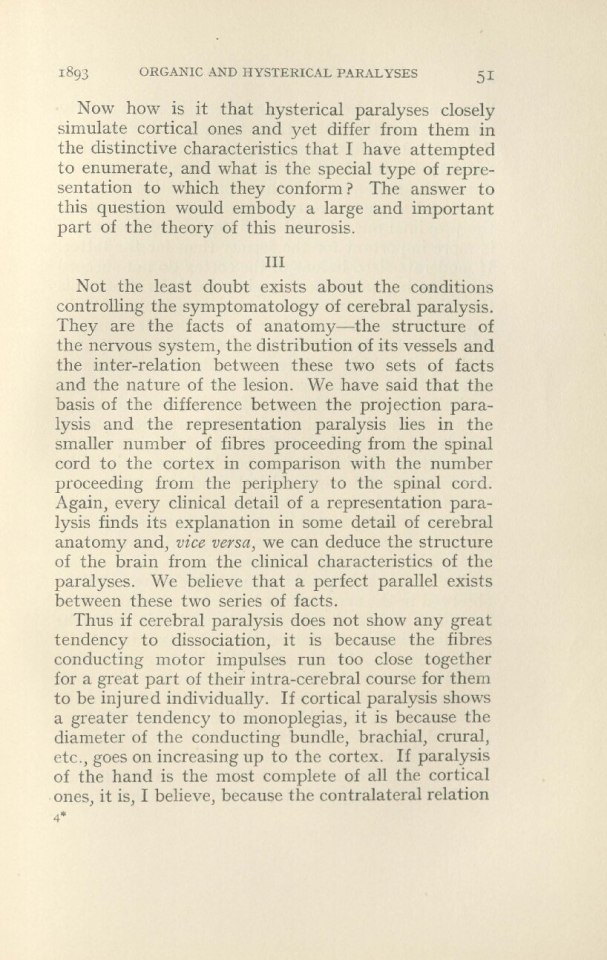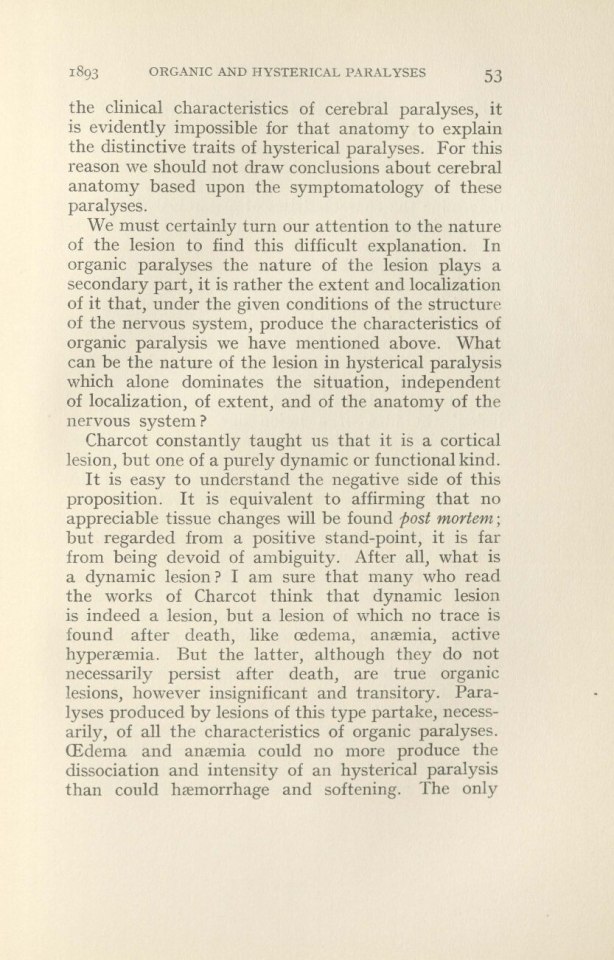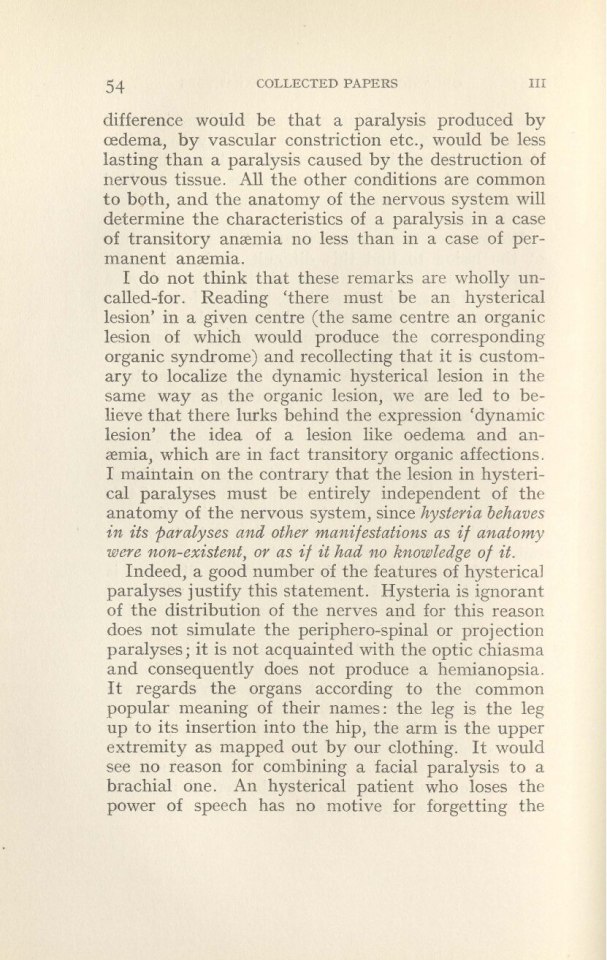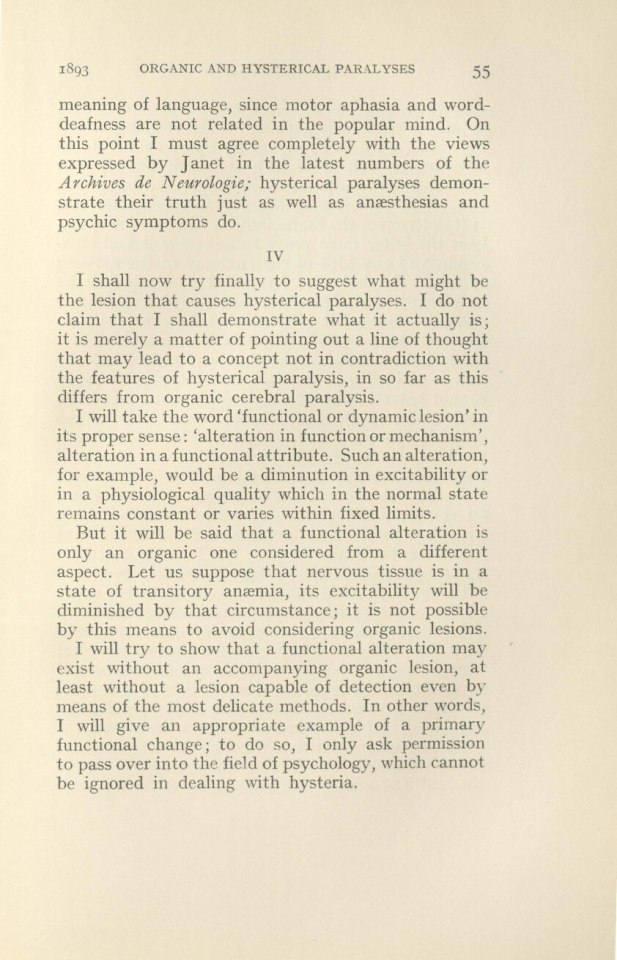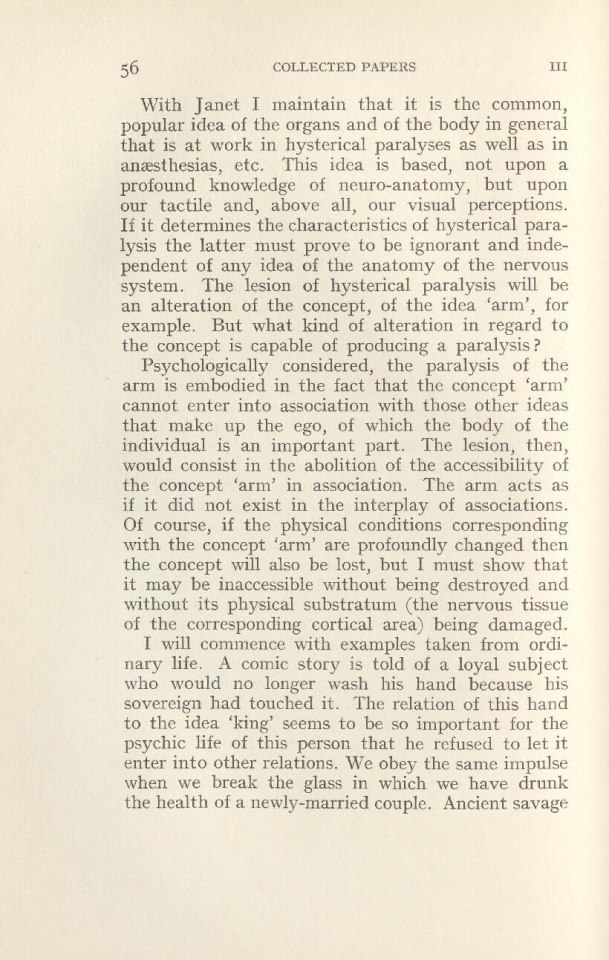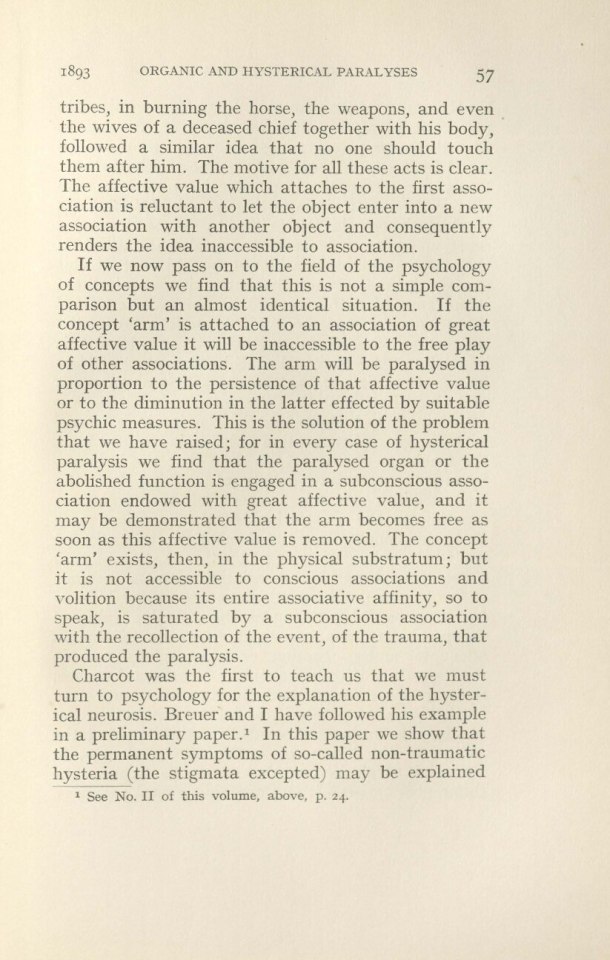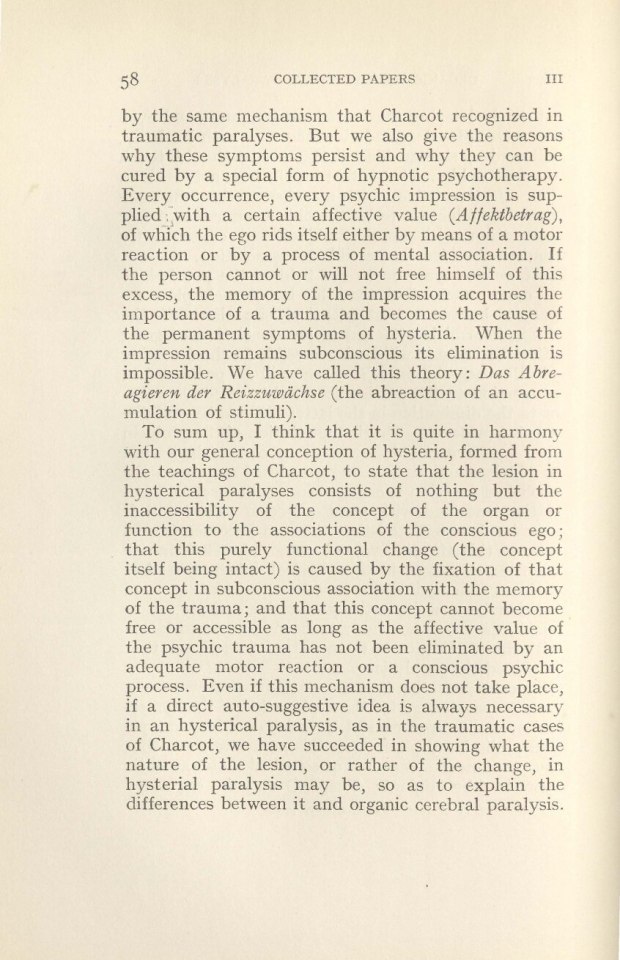S.
III
SOME POINTS IN A COMPARATIVE STUDY
OF ORGANIC AND HYSTERICAL PARALYSES!(1893)
n 1885 and 1886, when I was his pupil, Charcot
F: good enough to entrust me with the task ofmaking a comparative study of organic and hysteri-
cal motor paralyses, based upon observations at the
Salpetriere, which might serve to discover some of
the common characteristics of neuroses and lead to
a conception of their nature. Accidental and personal
reasons prevented me from following his suggestion
for a long time; even now I only intend to give an
account of some of the results of my work, omitting
the details needed for a complete demonstration of
my views.I
I must begin with some remarks on the nature of
organic paralyses, which incidentally represent gener-
ally accepted conclusions. Clinical neurology recog-
nizes two forms of motor paralyses: periphero-
spinal (or bulbar) and cerebral. This distinction is
entirely in harmony with the facts of the nervous
system, which show that there are only two segments
in the course of the motor fibres: one extending from
the periphery to the anterior horn cells of the spinal
cord, and a second which proceeds from here to the
cerebral cortex. Modern neuro-histology, based upon
the work of Golgi, Ramön y Cajal, Kölliker, etc.,
formulates these facts as follows: The path of fibres? First published in Archives de Neurologie, No. 77, 1803. [Trans-
lated by M. Meyer.]S.
1893 ORGANIC AND HYSTERICAL PARALYSES 43
conducting motor impulses consists of two neurones
(a neuro-histological unit composed of a cell and its
fibres) which meet in intimate relation at the so-
called motor cells of the anterior horn. The essential
clinical difference between these two types of paralysis
is the following: Periphero-spinal paralysis is a Dara-
Iysis of individual elements while cerebral baralysis is
a Paralysis en masse. Types of the former are the
facial palsy of Bell, the paralysis in infantile anterior
poliomyelitis, etc. Now in these diseases each muscle,
we might say each muscle fibre, may be paralysed
individually and in isolation. It depends only upon
the site and extent of the nerve lesion; there is,
moreover, no definite rule according to which one
peripheral element cscapes paralysis while another
is permanently subject to it.Cerebral paralysis, on the other hand, is always a
disease affecting a considerable portion of the peri-
phery, an extremity, a segment of it, or a complicated
motor apparatus. It never affects one muscle alone,
as for example, the biceps brachii or the tibialis; in
any apparent exceptions to this rule (cortical ptosis,
for example) it is evident that the muscles concerned
are of the kind which in themselves fulfil a particular
function—in which they are the sole agents.It may be noted that in cerebral paralyses affecting
the extremities distal segments always suffer more
than proximal ones; the hand, for example, is more
paralysed than the shoulder. As far as I know, there
is no isolated cerebral paralysis of the shoulder in
which the hand retains its motor power, while the
reverse is the rule in incomplete paralyses.In a critical study of aphasia, published in ı8gr
(Zur Auffassung der Aphasten, Wien, 1891), I attemp-
ted to show that the cause of this important difference
between periphero-spinal and cerebral paralysis wasS.
44 \ COLLECTED PAPERS 4
to be sought in the structure of the nervous system.
Each element in the periphery corresponds to one in
the grey substance, which is, as Charcot expresses it,
its neural terminus; the periphery is then, so to say,
projected on to the grey substance of the spinal
cord, point by point, element for element. I have
proposed that the particularized periphero-spinal
paralysis should be named ‘projection paralysis’.
The relation between the elements of the spinal
cord and those of the cortex is, however, different.
The number of conducting fibres would no longer
suffice for a second projection of the perıphery, to
the cortex. We must suppose that the fibres coming
from the spinal cord to the cortex no longer represent
single peripheral elements, but rather a group of
them; on the other hand, a peripheral element may
correspond to several spino-cortical fibres. The
change in arrangement occurs at the point where
the two segments of the motor system meet.Therefore I would say that the reproduction of the
periphery in the cortex is no longer an accurate one,
point for point; it is not a true projection. The rela-
tion is established so to say by representative fibres,
and I propose therefore to name the cerebral form
of paralysis ‘representation paralysis’.Naturally, when a projection paralysis is total and
very extensive, it too becomes a paralysis en masse
and its striking distinctive characteristic disappears.
Cortical paralysis, on the other hand, which is differ-
entiated from the other cerebral paralyses by a
greater tendency to dissociation, nevertheless in-
variably presents the character of a representation
paralysis.The other differences between projection paralysis
and representation paralysis are well known. Among
them I may mention the preservation of nutritionS.
1893 ORGANIC AND HYSTERICAL PARALYSES 45
and of electrical reaction in the latter. Although
clinically very important, these signs have not the
theoretical significance that is to be ascribed to the
first differential trait mentioned, i. e., whether the
paralysis be one of individual elements or en masse.Hysteria has often been credited with the faculty
of simulating the most varied kinds of organic nervous
diseases. The question arises whether it can simulate
accurately the characteristics of both types of organic
paralysis, whether there are hysterical projection
paralyses and hysterical representation paralyses, as
in the organic symptomatology. An important fact at
once confronts us here. Hysteria never simulates the
periphero-spinal or projection paralyses; hysterical
paralyses show the characteristics of organic re-
presentation paralyses only. This is indeed a very
interesting fact, since Bell’s palsy, musculo-spinal
paralysis, etc., are among the most common diseases
of the nervous system.It should be noted in this connection, in order to
avoid all confusion, that I am dealing only with
flaccid hysterical paralyses and not with hysterical
contractures. It seems to me impossible to apply
the same rules to both hysterical paralyses and
hysterical contractures. The contention that the
paralysis never affects an isolated muscle (unless
such a muscle be the sole agent of a function), that
the paralysis is always en masse, agreeing in this
respect with an organic cerebral representation para-
lysis, can only be maintained in respect of flaccid
hysterical paralyses. Further, in regard to the
nutrition and electrical reactions of the paralysed
part hysterical paralysis shows the same character-
istics as organic cerebral paralysis.But although hysterical paralysis may be related
in this way to cerebral and especially to corticalS.
46 COLLECTED PAPERS Im
paralysis, which exhibits a greater aptitude for disso-
ciation, important distinctive traits are not lacking
between them. In the first place, it is not subject to
the constant fixed rule of organic cerebral paralyses,
namely, that the distal segment is always more
extensively affected than the proximal one. In
hysteria, the shoulder or the thigh may be more
seriously paralysed than the hand or the foot. Move-
ments may occur in the fingers while the proximal
part is still absolutely motionless. There is not the
least difficulty in producing artificially an isolated
paralysis of the thigh, of the leg, etc., and clinically
we quite frequently meet with these isolated para-
lyses which do not conform to the rules of organic
cerebral paralyses.In this important respect hysterical paralysis is,
so to speak, intermediate in type between projection
paralysis and representation paralysis. On the one
handit doesnot possess all the characteristics of disso-
ciation and isolation proper to the former; on the other
hand it is by no means subject to the rules which
strietly govern the latter. With these reservations
we may say that hysterical paralysis also is a re-
presentation paralysis, butone possessingaspecialman-
ner of representation which remains to be dicovered.!u
As a step in this direction I propose to study the
other traits which differentiate hysterical paralysis+ I will state by the way that that important feature of hysterical
paralyses of the leg emphasized by Charcot, following Todd—namely,
that an hysteric drags his leg like a dead mass instead of performing
the circumduction of the hip commonly carried out in hemiplegia—is
easily explained by a characteristic of the neurosis already mentioned.
In organic hemiplegia, the proximal part of the extremity is always
more or less intact; the patient can move the hip and. uses it to
perform the cireumduction movement that carries the log forward,
In hysteria, the proximal part (the hip) does not enjoy that privilege:
the paralysis is as complete as in the distal part, and as a result
the leg must be dragged en masse.S.
1993 ORGANIC AND HYSTERICAL PARALYSES 47
from the most perfect form of cerebral organic para-
Iysis—namely, cortical paralysis. The first of these
distinguishing characteristics has been mentioned, the
fact that hysterical paralysis may be much more
dissociated and systematised than cerebral paralysis.
The symptoms of organic paralysis appear in hysteria
as if apportioned. Hysteria reproduces the common
organic hemiplegia (paralysis of the upper and lower
extremities and of the lower half of the face) only to
the extent of imitating the paralysis of the limbs;
frequently it even splits off the paralysis of the arm
from that of the leg, exhibiting with the greatest
ease paralysis in the form of a monoplegia. It re-
produces in an isolated form the motor aphasia
seen in the syndrome of organic aphasia and, as I
have observed in some unpublished cases, it can
create a total aphasia (motor and sensory) for a given
language, without affecting in the least the ability
to understand and to speak another, a phenomenon
unheard-of in organic aphasia. This power of disso-
ciation is again manifested in those isolated para-
Iyses in which one segment of a limb is affected while
other portions of the same limb are entirely intact, and
again, when one function is completely abolished
(abasia astasia) while another function performed
by thesame organ is unaffected. The more complex
the function in question, the more striking is this
dissociation. In organic disease, whenever several
functions are impaired in different degrees, it is
always the most complex function, the one most
recently acquired, that is most extensively affected
by the paralysis.In addition to the above, hysterical paralysis
presents another characteristic, which is, as it were,
the hall-mark of the neurosis. Indeed, as I heard
Charcot say, hysteria is a malady with extravagantS.
48 COLLECTED PAPERS I
manifestations, with a tendency to produce its
symptoms in the severest possible degree. This
characteristic is not met with only in the paralyses
but also in the contractures and anzsthesias. The
degree of distortion that may be produced by hyster-
ical contractures is well known and is hardly equalled
in organic symptomatology. We also know how
frequently hysteria exhibits the absolute, profound
anzesthesias, of which the organic lesions only re-
produce a faint sketch. The same is true of the
paralyses; they are often as complete as is possible.
The hysterical aphasic does not utter a word, while
the organic aphasic almost always retains a few
syllables, ‘yes’, ‘no’, an oath, etc.; the paralysed arm
is absolutely inert, and so on. This characteristic is
too well known to dwell on it at length. On the
other hand, it is known that in organic paralysis
partial paresis is always more common than complete
paralysis.Hysterical paralysis, then, shows an exact deli-
mitalion and an excessive intensity. It possesses these
two qualities simultaneously, and it is in this respect
that it contrasts most strongly with organic cerebral
paralysis, in which these two characteristics are never
associated. Monoplegias do exist in organic symptom-
atology also, but they are almost always mono-
plegias a potiori and not sharply delimited. If an
arm is paralysed in consequence of a cortical lesion,
there is almost always a minor concomitant affection
of the face and leg; and if this complication is no
longer visible at a given period, it existed never-
theless at the beginning of the disease. Cortical
monoplegia is indeed always a hemiplegia, of which
one part or another has been more or less effaced but
still remains recognizable. To go further, let us
suppose that the paralysis has affected the arm alone,S.
1593 ORGANIC AND HYSTERICAL PARALYSES 49
that it is a pure cortical monoplegia; in such a case
we shall see that the paralysis is one of moderate
degree. As this monoplegia increases in degree, and
as soon as it becomes a total paralysis, it at once
loses its characteristic of being a pure monoplegia
and will be accompanied by motor disturbances in
the leg or the face. It cannot become a complete
baralysis and at Ihe same time remain vestricted in
area.This is the very condition, however, that hysteri-
cal paralysis can easily accomplish, as we may see
daily in clinical work. For example, it may affect the
arm exclusively without showing a trace in the leg
or the face. Further, in the arm it is as complete as
a paralysis can possibly be, and this forms a striking
contrast to organic paralysis, a difference that gives
occasion for serious reflection.There are, of course, cases of hysterical paralysis
in which the degree of paralysis is not excessive and
in which the dissociation offers nothing remarkable.
Such cases are recognized by other traits; but they
are cases that do not bear the typical stamp of
neurosis and, since they cannot teach us anything
about the nature of the latter, are of no interest for
our present purpose.Let me add a few remarks of minor importance,
though they overstep the limits of my subject.To begin with, I may recall the fact that hysterical
paralyses are much more frequently accompanied by
sensory disturbances than are organic paralyses; such
disturbances are altogether more profound and fre-
quent in neurosis than in organic disease. Nothing
is more common than hysterical anzsthesia or anal-
gesia. Recollect, in contrast to this, how obstinately
sensation persists in cases of organic lesion. If a
peripheral nerve is cut, the anzsthesia will be less4
S.
50 COLLECTED PAPERS 1
extensive and intense than might be expected. When
an inflammatory process attacks the spinal nerves
or the spinal cord centres the result always is that
motility suffers in the first instance, while sensibility
remains or is merely diminished; for some part of
the nervous elements which have not been completely
destroyed always persists. With cerebral lesions the
frequency and the permanency of motor hemiplegia
is well known, while the accompanying hemian-
zsthesia is vague and transitory, and is not always
present. Only a few special localizations can produce
a marked and lasting sensory disturbance (carrefour
sensitif), and even this fact is not free from doubt.This difference in the nature of the sensory disturb-
ances in organic lesions and in hysteria is scarcely
explicable with our present knowledge. The solution
of this problem would probably reveal the core of
the whole matter.Another point that seems to me worthy of mention
is that there are some forms of cerebral paralysis
which, just like the periphero-spinal projection para-
lyses, are not found in hysteria. Paralysis of the lower
half of the face, the most frequent manifestation of
organic brain disease, should be mentioned first in
this connection, and, if I may be permitted to enter
the field of sensorial disturbances, homonymus lateral
hemianopsia. I know that I run a risk in stating that
a given symptom does not exist in hysteria when the
researches of Charcot and his pupils are almost daily
discovering new and hitherto unsuspected symptoms.
But I must take things as they are at the moment.
The existence of an hysterical facial paralysis is
seriously contested by Charcot, and, even if we
believe those who vouch for it, it is a very rare
phenomenon. Hemianopsia has not as yet been
seen in hysteria, and I believe it never will be.S.
1893 ORGANIC AND HYSTERICAL PARALYSES 5I
Now how is it that hysterical paralyses closely
simulate cortical ones and yet differ from them in
the distinctive characteristics that I have attempted
to enumerate, and what is the special type of repre-
sentation to which they conform? The answer to
this question would embody a large and important
part of the theory of this neurosis.m
Not the least doubt exists about the conditions
controlling the symptomatology of cerebral paralysis.
They are the facts of anatomy—the structure of
the nervous system, the distribution of its vessels and
the inter-relation between these two sets of facts
and the nature of the lesion. We have said that the
basis of the difference between the projection para-
lysis and the representation paralysis lies in the
smaller number of fibres proceeding from the spinal
cord to the cortex in comparison with the number
proceeding from the periphery to the spinal cord.
Again, every clinical detail of a representation para-
lysis finds its explanation in some detail of cerebral
anatomy and, vice versa, we can deduce the structure
of the brain from the clinical characteristics of the
paralyses. We believe that a perfect parallel exists
between these two series of facts.Thus if cerebral paralysis does not show any great
tendency to dissociation, it is because the fibres
conducting motor impulses run too close together
for a great part of their intra-cerebral course for them
to be injured individually. If cortical paralysis shows
a greater tendency to monoplegias, it is because the
diameter of the conducting bundle, brachial, crural,
ete., goes on increasing up to the cortex. If paralysis
of the hand is the most complete of all the cortical
ones, it is, I believe, because the contralateral relation.*
S.
COLLECTED PAPERS II
between hemisphere and periphery is more nearly
complete for the hand than for any other part of
the body. If the distal segment of an extremity suffers
a greater degree of paralysis than a proximal segment,
it may be assumed that the representative fibres of
the distal segment are more numerous than those of
the proximal one, so that the influence of the cortex
is more important for the former than for the latter.
If moderate-sized lesions of the cortex do not succeed
in producing pure monoplegias, we infer from this
that the motor centres of the cortex are not cleanly
separated from one another by indifferent areas, or
that there are factors operating at a distance (Fern-
wirkungen) which nullify the effect of an exact
separation of the centres.Similarly, if disturbances of various functions are
always found in a mixed form in organic aphasia,
this is explained by the fact that branches of the
same artery nourish all the speech centres, or, if the
view expressed in my critical study of aphasia is
accepted, it is because we are dealing, not with
separate centres, but with a continuous association
area. In any event, there is always some reason to
be found in anatomy for these things.The remarkable combinations which are so often
observed in the symptomatology of cortical paralyses
(motor aphasia and right hemiplegia, alexia and right
hemianopsia) are explained by the proximity of the
injured centres. Hemianopsia itself, a symptom that
seems curious and strange to the unscientific mind,
is only explicable by the crossing of the fibres of the
optic nerve at the chiasma; like all the details of
cerebral paralyses it is the clinical expression of an
anatomical fact.Since there cannot be more than one authentic
cerebral anatomy, and since that one is expressed inS.
1893 ORGANIC AND HYSTERICAL PARALYSES 53
the clinical characteristics of cerebral paralyses, it
is evidently impossible for that anatomy to explain
the distinctive traits of hysterical paralyses. For this
reason we should not draw conclusions about cerebral
anatomy based upon the symptomatology of these
paralyses.‚We must certainly turn our attention to the nature
of the lesion to find this difficult explanation. In
organic paralyses the nature of the lesion plays a
secondary part, it is rather the extent and localization
of it that, under the given conditions of the structure
of the nervous system, produce the characteristics of
organic paralysis we have mentioned above. What
can be the nature of the lesion in hysterical paralysis
which alone dominates the situation, independent
of localization, of extent, and of the anatomy of the
nervous system ?Charcot constantly taught us that it is a cortical
lesion, but one of a purely dynamic or functional kind.It is easy to understand the negative side of this
proposition. It is equivalent to affirming that no
appreciable tissue changes will be found post mortem;
but regarded from a positive stand-point, it is far
{from being devoid of ambiguity. After all, what is
a dynamic lesion? I am sure that many who read
the works of Charcot think that dynamic lesion
is indeed a lesion, but a lesion of which no trace is
found after death, like oedema, anzmia, active
hyperemia. But the latter, although they do not
necessarily persist after death, are true organic
lesions, however insignificant and transitory. Para-
lyses produced by lesions of this type partake, necess-
arily, of all the characteristics of organic paralyses.
Edema and ansmia could no more produce the
dissociation and intensity of an hysterical paralysis
than could hemorrhage and softening. The onlyS.
54 COLLECTED PAPERS I
difference would be that a paralysis produced by
cedema, by vascular constriction etc., would be less
lasting than a paralysis caused by the destruction of
nervous tissue. All the other conditions are common
to both, and the anatomy of the nervous system will
determine the characteristics of a paralysis in a case
of transitory ansmia no less than in a case of per-
manent ansemia.I do not think that these remarks are wholly un-
called-for. Reading “there must be an hysterical
lesion’ in a given centre (the same centre an organic
lesion of which would produce the corresponding
organic syndrome) and recollecting that it is custom-
ary to localize the dynamic hysterical lesion in the
same way as the organic lesion, we are led to be-
lieve that there lurks behind the expression ‘dynamic
lesion’ the idea of a lesion like oedema and an-
mia, which are in fact transitory organic affections.
I maintain on the contrary that the lesion in hysteri-
cal paralyses must be entirely independent of the
anatomy of the nervous system, since hysteria behaves
in its paralyses and other manifestations as if anatomy
were non-existent, or as if it had no knowledge of it.Indeed, a good number of the features of hysterical
paralyses justify this statement. Hysteria is ignorant
of the distribution of the nerves and for this reason
does not simulate the periphero-spinal or projection
paralyses;; it is not acquainted with the optic chiasma
and consequently does not produce a hemianopsia.
It regards the organs according to the common
popular meaning of their names: the leg is the leg
up to its insertion into the hip, the arm is the upper
extremity as mapped out by our clothing. It would
see no reason for combining a facial paralysis to a
brachial one. An hysterical patient who loses the
power of speech has no motive for forgetting theS.
1593 ORGANIC AND HYSTERICAL PARALYSES 55
meaning of language, since motor aphasia and word-
deafness are not related in the popular mind. On
this point I must agree completely with the views
expressed by Janet in the latest numbers of the
Archives de Neurologie; hysterical paralyses demon-
strate their truth just as well as anzsthesias and
psychic symptoms do.IV
I shall now try finally to suggest what might be
the lesion that causes hysterical paralyses. I do not
claim that I shall demonstrate what it actually is;
it is merely a matter of pointing out a line of thought
that may lead to a concept not in contradiction with
the features of hysterical paralysis, in so far as this
differs from organic cerebral paralysis.I will take the word “functional or dynamic lesion’ in
its proper sense: ‘alteration in function or mechanism’,
alteration ina functionalattribute. Such an alteration,
for example, would be a diminution in exeitability or
in a physiological quality which in the normal state
remains constant or varies within fixed limits.But it will be said that a functional alteration is
only an organic one considered from a different
aspect. Let us suppose that nervous tissue is in a
state of transitory anzmia, its excitability will be
diminished by that circumstance; it is not possible
by this means to avoid considering organic lesions.I will try to show that a functional alteration may
exist without an accompanying organic lesion, at
least without a lesion capable of detection even by
means of the most delicate methods. In other words,
I will give an appropriate example of a primary
functional change; to do so, I only ask permission
to pass over into the field of psychology, which cannot
be ignored in dealing with hysteria,S.
56 COLLECTED PAPERS II
With Janet I maintain that it is the common,
popular idea of the organs and of the body in general
that is at work in hysterical paralyses as well as in
anzsthesias, etc. This idea is based, not upon a
profound knowledge of neuro-anatomy, but upon
our tactile and, above all, our visual perceptions.
I£ it determines the characteristics of hysterical para-
lysis the latter must prove to be ignorant and inde-
pendent of any idea of the anatomy of the nervous
system. The lesion of hysterical paralysis will be
an alteration of the concept, of the idea ‘arm’, for
example. But what kind of alteration in regard to
the concept is capable of producing a paralysis ?Psychologically considered, the paralysis of the
arm is embodied in the fact that the concept ‘arm’
cannot enter into association with those other ideas
that make up the ego, of which the body of the
individual is an important part. The lesion, then,
would consist in the abolition of the accessibility of
the concept ‘arm’ in association. The arm acts as
if it did not exist in the interplay of associations.
Of course, if the physical conditions corresponding
with the concept ‘arm’ are profoundly changed then
the concept will also be lost, but I must show that
it may be inaccessible without being destroyed and
without its physical substratum (the nervous tissue
of the corresponding cortical area) being damaged.I will commence with examples taken from ordi-
nary life. A comic story is told of a loyal subject
who would no longer wash his hand because his
sovereign had touched it. The relation of this hand
to the idea ‘king’ seems to be so important for the
psychic life of this person that he refused to let it
enter into other relations. We obey the same impulse
when we break the glass in which we have drunk
the health of a newly-married couple. Ancient savageS.
1893 ORGANIC AND HYSTERICAL PARALYSES 57
tribes, in burning the horse, the weapons, and even
the wives of a deceased chief together with his body,
followed a similar idea that no one should touch
them after him. The motive for all these acts is clear.
The affective value which attaches to the first asso-
ciation is reluctant to let the object enter into a new
association with another object and consequently
renders the idea inaccessible to association.If we now pass on to the field of the psychology
of concepts we find that this is not a simple com-
parison but an almost identical situation. If the
concept ‘arm’ is attached to an association of great
affective value it will be inaccessible to the free play
of other associations. The arm will be paralysed in
proportion to the persistence of that affective value
or to the diminution in the latter effected by suitable
psychic measures. This is the solution of the problem
that we have raised; for in every case of hysterical
paralysis we find that the paralysed organ or the
abolished function is engaged in a subconscious asso-
ciation endowed with great affective value, and it
may be demonstrated that the arm becomes free as
soon as this affective value is removed. The concept
‘arm’ exists, then, in the physical substratum; but
it is not accessible to conscious associations and
volition because its entire associative affinity, so to
speak, is saturated by a subconscious association
with the recollection of the event, of the trauma, that
produced the paralysis.Charcot was the first to teach us that we must
turn to psychology for the explanation of the hyster-
ical neurosis. Breuer and I have followed his example
in a preliminary paper.' In this paper we show that
the permanent symptoms of so-called non-traumatic
hysteria (the stigmata excepted) may be explained1 See No. II of this volume, above, p. 24.
S.
5 ° COLLECTED PAPERS m
by the same mechanism that Charcot recognized in
traumatic paralyses. But we also give the reasons
why these symptoms persist and why they can be
cured by a special form of hypnotic psychotherapy.
Every occurrence, every psychic impression is sup-
plied: with a certain affective value (Affektbetrag),
of which the ego rids itself either by means of a motor
reaction or by a process of mental association. If
the person cannot or will not free himself of this
excess, the memory of the impression acquires the
importance of a trauma and becomes the cause of
the permanent symptoms of hysteria. When the
impression remains subconscious its elimination is
impossible. We have called this theory: Das Abre-
agieren der Reizzuwächse (the abreaction of an accu-
mulation of stimuli).To sum up, I think that it is quite in harmony
with our general conception of hysteria, formed from
the teachings of Charcot, to state that the lesion in
hysterical paralyses consists of nothing but the
inaccessibility of the concept of the organ or
function to the associations of the conscious ego;
that this purely functional change (the concept
itself being intact) is caused by the fixation of that
concept in subconscious association with the memory
of the trauma; and that this concept cannot become
free or accessible as long as the affective value of
the psychic trauma has not been eliminated by an
adequate motor reaction or a conscious psychic
process. Even if this mechanism does not take place,
if a direct auto-suggestive idea is always necessary
in an hysterical paralysis, as in the traumatic cases
of Charcot, we have succeeded in showing what the
nature of the lesion, or rather of the change, in
hysterial paralysis may be, so as to explain the
differences between it and organic cerebral paralysis.
freud-1924-cp-1
42
–58
